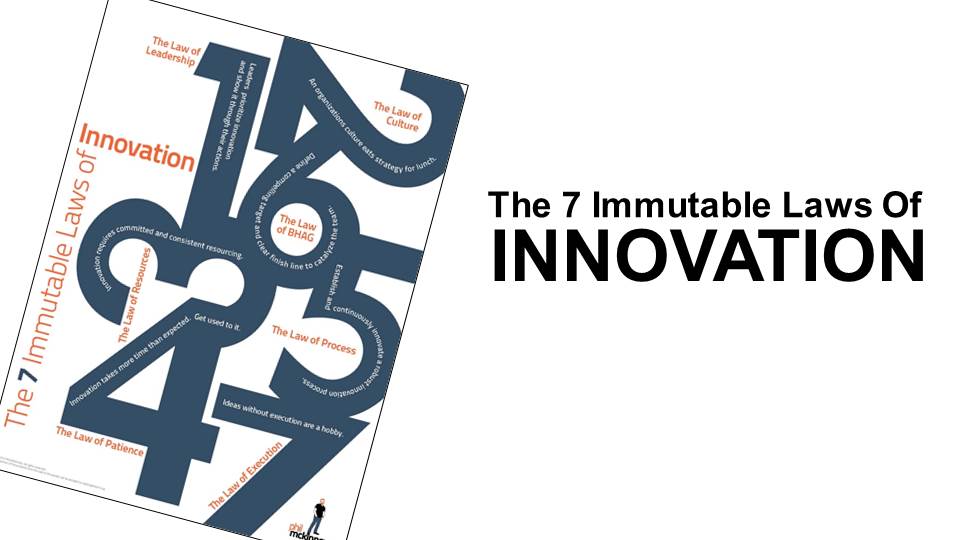The 7 Immutable Laws of Innovation – Follow them or risk the consequences
. ? Over the years of being in the innovation space, I’ve discovered a set of laws by trial and error. I have the scars from the school of hard knocks to validate that these 7 laws of innovation are critical for innovation success. If you violate any one of them, the consequences can be […]

. ? Over the years of being in the innovation space, I’ve discovered a set of laws by trial and error. I have the scars from the school of hard knocks to validate that these 7 laws of innovation are critical for innovation success. If you violate any one of them, the consequences can be disastrous. These laws apply to all sizes of organizations, ranging from well-established multinationals to early-stage start-ups to governments.
What Are The Laws of Innovation?
The 7 laws of innovation are critical for innovation success. If you violate them, the consequences can be disastrous.
Phil McKinney
Do I use these 7 laws of innovation? No single organization has it all figured out. By taking an honest audit of your innovation programs against the laws, you can identify the areas that work and those that don't.
1) The Law of Leadership:
Executive-level support (Board, CEO, and his/her direct reports) is critical for an organization that wants to have innovation at its core. Leadership means talking the talk AND walking the walk. It means committing (and protecting) resources (time, money, people, equipment) for innovation. How much time does the executive team as a group and individually spend working on innovation? Listening to status reports from others doesn’t count.
2) The Law of Culture:
Establishing and nurturing an innovation culture sets the foundation for the organization. For leaders, it means rewarding the right behavior (teamwork, collaboration, honesty, trust) and identifying and eliminating destructive behavior (not-invented-here, passive/aggressive, turf battles). The key items in a robust culture of innovation are:
- People: Every person feels ownership of the innovation agenda and is equipped and skilled to have an impact.
- Ideas: Ideas are actively solicited from all sources and valued and nurtured, not criticized or minimized.
- Alignment: All resources are aligned against the innovation agenda to ensure everyone is pulling in the same direction.
- Communication: Communication that is clear, honest, respectful, and transparent is essential for teamwork and establishing trust within the organization.
3) The Law of Resources:
Innovation requires a committed level of resources (people, money, time, equipment) over an extended period of time. The level of resourcing is the validation of the importance and commitment the organization devotes to innovation. Does the executive team commit the best resources to innovation? Are the resources protected?
4) The Law of Patience:
Innovation takes time. More time than expected. The organization must take the long view on innovation and avoid the temptation and resist the pressure for short-term adjustments. Annual resets of budgets force innovation to take on a short-term planning horizon. If they adjust the budget to help the organization meet quarterly budget challenges, then most likely, the Law of Leadership is NOT in place. Don’t fall into the trap of the “Rule of 18”. Are resources committed beyond the traditional budget planning cycle?
5) The Law of Process:
To succeed at innovation, organizations need an innovation process that fits and works within their organization and culture. The process should cover the full innovation chain from idea capture through the last steps of execution. This includes establishing and tracking a set of metrics that measures the success and areas of improvement within the innovation program.
6) The Law Of BHAG:
What is a BHAG? A BHAG is “Big Hairy Audacious Goal”. It’s what leadership lays out as the innovation agenda. The BHAG sets a clear and compelling target, serves as a unifying focal point of effort, and acts as a clear catalyst for team spirit. It has a clear finish line, so the organization will know when it has achieved the goal. It does NOT prescribe the how. John F. Kennedy didn’t design the rockets that got the U.S. to the moon. He set the BHAG.
7) The Law Of Execution:
The ability to execute on both the innovation agenda and the quarterly objectives of the operating business is a key skill that the organization needs to have. Focusing on only one area of execution leaves the other to flounder. Segmenting the execution roles into separate silos works against the Law of Culture.
Note: You can purchase the poster of the 7 Laws of Innovation over at Innovation.Tools. 100% of the proceeds goes to HackingAutism.org
Phil McKinney Newsletter
Join the newsletter to receive the latest updates in your inbox.




